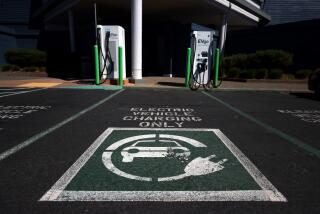Group dreams up ‘green’ van
As concern over the dangers of global warming grows, the auto industry has an opportunity to take a leading role in fighting it, a prominent environmental group said Thursday.
Instead of suing to block state-mandated reductions in carbon dioxide, a primary cause of climate warming, automakers could pull enough existing technology from their parts shelves to cut emissions of the so-called greenhouse gas by 40%, the Union of Concerned Scientists said.
To prove the point, the Washington-based group unveiled a blueprint for a climate-friendly minivan it calls the Vanguard.
It would run on a blend on 85% gasoline and 15% ethanol and could achieve 22 miles per gallon in combined city and highway driving. That’s the equivalent of 28 mpg on conventional gasoline.
Technologies would include a turbocharged six-cylinder engine that would shut down two cylinders when cruising, a fuel-efficient six-speed automatic transmission and electric power steering.
Although those technologies are in use today, “they’ve never been all put together in one vehicle,” said the group’s Spencer Quong, an engineer in Berkeley who designed the Vanguard.
He estimated that in California alone, use of the Vanguard technologies would eliminate 73 million tons of carbon dioxide in 2030 -- an amount equal to taking 19.1 million of today’s passenger vehicles off the road.
Chris Martin, a spokesman for Honda Motor Co.’s U.S. arm in Torrance, said that the vehicle the environmental group designed existed only as a computer model and questioned whether it could be easily and economically built.
“But we support all efforts to improve the environment, and we already have many of these technologies in use on our vehicles,” Martin said.
Honda boasts the auto industry’s best overall fuel economy and would be least affected by laws limiting greenhouse gases. The rules affect fuel economy because carbon dioxide is produced in proportion to the amount of fuel a vehicle burns.
Turning out vehicles based on the Vanguard model would take a concerted effort and would have to be phased in as various car and truck models were redesigned, said David Friedman, research director for the Union of Concerned Scientists’ clean-vehicle program. But the additional features would add only about $300 to the average price, he said.
Fuel savings alone over five years of ownership could put $1,300 into an owner’s pockets, Friedman said. When all factors are considered, he said, “the $300 additional cost could be repaid in 19 months.”
California and 10 other states have adopted rules requiring automakers to slash greenhouse gas emissions from their vehicles by as much as 34% by 2016.
The legislation has been challenged in federal lawsuits filed in California, Vermont and Rhode Island by the Alliance of Automobile Manufacturers, a lobbying group that represents most major automakers.
The initial measure to reduce automotive carbon dioxide emissions was approved in 2002 by California.
Because of its severe air pollution, California is the only state allowed to institute its own auto emissions regulations. Other states must either use the U.S. standards or adopt the stricter California rules. Those that have emulated California are Connecticut, Maine, Massachusetts, New Jersey, New York, Pennsylvania, Rhode Island, Vermont, Oregon and Washington.
Gloria Bergquist, a spokeswoman for the automaker alliance, said the industry lawsuits challenged not the technology but the idea that individual states could adopt what amounts to their own fuel economy standards.
Automakers in the U.S. “have 200 models on sale today that achieve 30 miles per gallon on the highway,” she said. “Many of the technologies the Union of Concerned Scientists talks about were developed with substantial effort and expense by auto companies. But we can’t let California set its own fuel efficiency standards. Those have to be national,” she said.
By fighting the rules, the environmental group’s Friedman said, automakers are sticking to a “can’t do” philosophy.
“To get the job done, they should bench their lawyers and call in the engineers.”






